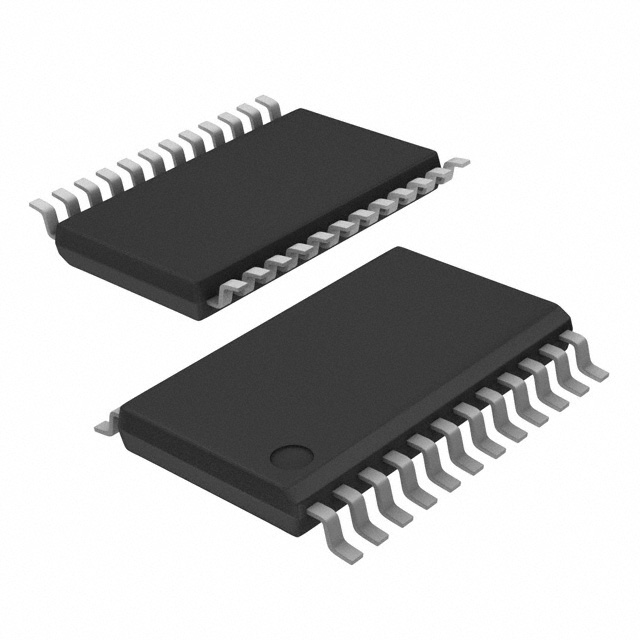Viz Specifikace pro podrobnosti o produktu.

CD4067BPW
Product Overview
Category
CD4067BPW belongs to the category of integrated circuits (ICs).
Use
This IC is commonly used for analog multiplexing and demultiplexing applications.
Characteristics
- CD4067BPW is a 16-channel analog multiplexer/demultiplexer.
- It operates with a wide supply voltage range of 3V to 18V.
- The IC has low ON resistance and low crosstalk between channels.
- It offers high channel isolation and excellent signal integrity.
Package
CD4067BPW is available in a standard 24-pin TSSOP (Thin Shrink Small Outline Package) package.
Essence
The essence of CD4067BPW lies in its ability to efficiently switch and route analog signals across multiple channels.
Packaging/Quantity
CD4067BPW is typically sold in reels containing 2500 units per reel.
Specifications
- Supply Voltage Range: 3V to 18V
- Analog Signal Range: 0V to VDD
- ON Resistance: 80Ω (typical)
- Channel-to-Channel Crosstalk: -70dB (typical)
- Channel Isolation: -90dB (typical)
- Operating Temperature Range: -40°C to +85°C
Detailed Pin Configuration
- INHIBIT (INH)
- Enable (EN)
- Channel Select (S0)
- Channel Select (S1)
- Channel Select (S2)
- Channel Select (S3)
- Channel Common (COM)
- Channel 0 (CH0)
- Channel 1 (CH1)
- Channel 2 (CH2)
- Channel 3 (CH3)
- Channel 4 (CH4)
- Channel 5 (CH5)
- Channel 6 (CH6)
- Channel 7 (CH7)
- Channel 8 (CH8)
- Channel 9 (CH9)
- Channel 10 (CH10)
- Channel 11 (CH11)
- Channel 12 (CH12)
- Channel 13 (CH13)
- Channel 14 (CH14)
- Channel 15 (CH15)
- VDD
Functional Features
- CD4067BPW allows for bidirectional analog signal routing.
- It provides a wide range of channel selection options.
- The IC offers low ON resistance, minimizing signal distortion.
- It ensures high channel isolation, reducing cross-channel interference.
- CD4067BPW has a built-in inhibit function to disable all channels simultaneously.
Advantages and Disadvantages
Advantages
- Wide supply voltage range allows for versatile applications.
- Low ON resistance ensures minimal signal loss.
- High channel isolation improves signal integrity.
- Compact TSSOP package saves board space.
- Cost-effective solution for analog multiplexing/demultiplexing needs.
Disadvantages
- Limited number of channels (16) compared to some other ICs in the same category.
- Not suitable for high-frequency applications due to limited bandwidth.
Working Principles
CD4067BPW operates based on the principle of analog multiplexing and demultiplexing. It uses a combination of control signals (S0-S3) to select the desired input or output channel. When a specific channel is selected, the corresponding analog signal is routed through the COM pin. The IC's low ON resistance ensures minimal signal distortion during the switching process.
Detailed Application Field Plans
CD4067BPW finds applications in various fields, including:
- Data acquisition systems
- Audio/video signal routing
- Instrumentation and measurement equipment
- Industrial automation
- Communication systems
- Test and measurement setups
- Medical devices
- Automotive electronics
Detailed and Complete Alternative Models
- CD4051BPW: 8-channel analog multiplexer/demultiplexer.
- CD4052BPW: Dual 4-channel analog multiplexer/demultiplexer.
- CD4053BPW: Triple 2-channel analog multiplexer/demultiplexer.
- CD4051BNSR: Surface mount 8-channel analog multiplexer/demultiplexer.
- CD4052BNSR: Surface mount dual 4-channel analog multiplexer/demultiplexer.
- CD4053BNSR: Surface mount triple 2-channel analog multiplexer/demultiplexer.
These alternative models offer different channel configurations and package options to suit specific application requirements.
Word count: 515 words
Seznam 10 běžných otázek a odpovědí souvisejících s aplikací CD4067BPW v technických řešeních
Sure! Here are 10 common questions and answers related to the application of CD4067BPW in technical solutions:
Q: What is CD4067BPW? A: CD4067BPW is a multiplexer/demultiplexer integrated circuit (IC) that allows multiple analog or digital signals to be routed through a single channel.
Q: What is the purpose of CD4067BPW? A: The purpose of CD4067BPW is to simplify signal routing and reduce the number of required input/output pins in electronic circuits.
Q: How many channels does CD4067BPW have? A: CD4067BPW has 16 channels, which means it can handle up to 16 different input or output signals.
Q: Can CD4067BPW handle both analog and digital signals? A: Yes, CD4067BPW can handle both analog and digital signals, making it versatile for various applications.
Q: What is the voltage range supported by CD4067BPW? A: CD4067BPW supports a wide voltage range from 3V to 18V, making it compatible with different power supply levels.
Q: How do I select a specific channel using CD4067BPW? A: Channel selection is done by providing a binary address to the control pins of CD4067BPW, allowing you to choose the desired channel.
Q: Can CD4067BPW be cascaded to increase the number of channels? A: Yes, CD4067BPW can be cascaded by connecting the output of one IC to the input of another, enabling expansion of the number of channels.
Q: What is the maximum frequency at which CD4067BPW can operate? A: CD4067BPW can operate at frequencies up to 50 MHz, making it suitable for high-speed applications.
Q: Can CD4067BPW be used in both digital and analog multiplexing applications? A: Yes, CD4067BPW can be used in both digital and analog multiplexing applications, providing flexibility in various circuit designs.
Q: Are there any precautions to consider when using CD4067BPW? A: It is important to ensure that the voltage levels of the signals being routed through CD4067BPW are within its specified operating range to prevent damage or incorrect operation.
Please note that these answers are general and may vary depending on specific application requirements and circuit design considerations.

